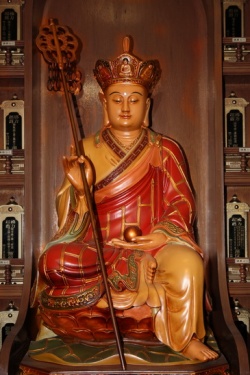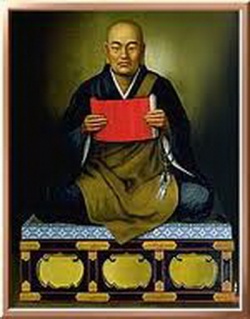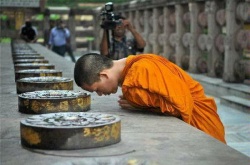Difference between revisions of "Two Schools of Buddhism"
(Created page with " However extraordinarily rich and extensive the Pāḷi {{Wiki|literature}} of India, Ceylon and Burma may be, still it represents only the {{Wiki|literature}}...") |
|||
| Line 1: | Line 1: | ||
| − | + | {{DisplayImages|1844|3635|2779|686}} | |
| + | : However extraordinarily rich and extensive the [[Pāḷi]] {{Wiki|literature}} of [[India]], [[Ceylon]] and [[Burma]] may be, still it represents only the {{Wiki|literature}} of one [[sect]] of the [[Buddhists]]. | ||
| − | Alongside of it in [[India]] itself and apart from the other countries where [[Buddhism]] is the dominant [[religion]], several sects have developed their [[own]] {{Wiki|literary}} productions, the [[language]] of which is partly [[Sanskrit]] and partly a {{Wiki|dialect}} which we may call the mid-Indian and which is given the designation of “mixed [[Sanskrit]]” by Senart | + | Alongside of it in [[India]] itself and apart from the other countries where [[Buddhism]] is the dominant [[religion]], several sects have developed their [[own]] {{Wiki|literary}} productions, the [[language]] of which is partly [[Sanskrit]] and partly a {{Wiki|dialect}} which we may call the mid-Indian and which is given the designation of “mixed [[Sanskrit]]” by Senart. |
| − | The most [[ancient]] [[Buddhist]] school, the [[doctrine]] of which coincides with that of the [[Theravāda]], as perpetuated in [[Pāḷi]] [[tradition]], sees in {{Wiki|salvation}} or [[Nirvāṇa]] the [[supreme bliss]] and in the {{Wiki|conception}} of [[Arhatship]], which is already in this [[life]] a foretaste of the coming [[Nirvāṇa]], the end and goal of all strivings - a goal which is attainable only by a few with the help of a [[knowledge]] which is to be acquired only in [[ascetic]] [[life]]. This original [[objective]] of [[early Buddhism]] has not been rejected by the {{Wiki|adherents}} of the later or [[Mahāyāna school]]. On the other hand, it has been recognised as originating with the [[Buddha]] himself. It is characterised as the [[Hīnayāna]] or the ‘[[inferior vehicle]]’ which does not suffice [4] to conduct all [[beings]] to [[cessation]] of [[sorrow]]. What the later [[doctrine]] teaches is the [[Mahāyāna]] or the ‘[[great vehicle]]’ which is calculated to transport a larger number of [[people]], the whole {{Wiki|community}} of [[humanity]], over and beyond the [[sorrow]] of [[existence]]. This [[new doctrine]], as is claimed by its followers, rests upon a profounder [[understanding]] of the [[ancient]] texts or upon later [[mystical]] [[revelation]] of the [[Buddha]] himself and it replaces the {{Wiki|ideal}} of the [[Arhat]] by that of the [[Bodhisattva]]. Not only the [[monk]] but every ordinary [[human being]] can place before himself the goal to be [[re-born]] as a [[Bodhisattva]], which means an [[enlightened being]] or one who may receive supreme [[illumination]] and bring {{Wiki|salvation}} to all mankind. | + | Of this [[Sanskrit]] {{Wiki|literature}} there have remained to us many voluminous [[books]] and fragments of several others while many are known to us only through [[Tibetan]] and {{Wiki|Chinese}} translations. |
| + | |||
| + | The major portion of this {{Wiki|literature}}, in [[pure]] and mixed [[Sanskrit]], which we for brevity's sake call [[Buddhist Sanskrit]] {{Wiki|literature}}, belongs either to the school known as that of the [[Mahāyāna]] or has been more or less influenced by the [[latter]]. | ||
| + | |||
| + | For an [[appreciation]], therefore, of this {{Wiki|literature}} it is necessary in the first place to make a few observations on the [[schism]] in [[Buddhism]] which divided it early into two schools, the [[Mahāyāna]] and the [[Hīnayāna]]. | ||
| + | |||
| + | The most [[ancient]] [[Buddhist]] school, the [[doctrine]] of which coincides with that of the [[Theravāda]], as perpetuated in [[Pāḷi]] [[tradition]], sees in {{Wiki|salvation}} or [[Nirvāṇa]] the [[supreme bliss]] and in the {{Wiki|conception}} of [[Arhatship]], which is already in this [[life]] a foretaste of the coming [[Nirvāṇa]], the end and goal of all strivings - a goal which is attainable only by a few with the help of a [[knowledge]] which is to be acquired only in [[ascetic]] [[life]]. | ||
| + | |||
| + | |||
| + | This original [[objective]] of [[early Buddhism]] has not been rejected by the {{Wiki|adherents}} of the later or [[Mahāyāna school]]. On the other hand, it has been recognised as originating with the [[Buddha]] himself. | ||
| + | |||
| + | It is characterised as the [[Hīnayāna]] or the ‘[[inferior vehicle]]’ which does not suffice [4] to conduct all [[beings]] to [[cessation]] of [[sorrow]]. | ||
| + | |||
| + | What the later [[doctrine]] teaches is the [[Mahāyāna]] or the ‘[[great vehicle]]’ which is calculated to transport a larger number of [[people]], the whole {{Wiki|community}} of [[humanity]], over and beyond the [[sorrow]] of [[existence]]. | ||
| + | |||
| + | This [[new doctrine]], as is claimed by its followers, rests upon a profounder [[understanding]] of the [[ancient]] texts or upon later [[mystical]] [[revelation]] of the [[Buddha]] himself and it replaces the {{Wiki|ideal}} of the [[Arhat]] by that of the [[Bodhisattva]]. | ||
| + | |||
| + | Not only the [[monk]] but every ordinary [[human being]] can place before himself the goal to be [[re-born]] as a [[Bodhisattva]], which means an [[enlightened being]] or one who may receive supreme [[illumination]] and bring {{Wiki|salvation}} to all mankind. | ||
| + | |||
| + | If this goal is to be made attainable by many there must be more efficient means for making it accessible to all than are to be found in the [[Hīnayāna]] [[doctrine]]. | ||
| + | |||
| + | Therefore, according to the [[doctrine]] of the [[Mahāyāna]], even the father of a family occupied with [[worldly life]], the {{Wiki|merchant}}, the craftsman, the sovereign - nay, even the labourer and the pariah - can attain to {{Wiki|salvation}} on the one hand, by the [[practice]] of {{Wiki|commiseration}} and [[goodwill]] for all creatures, by [[extraordinary]] [[generosity]] and self-abnegation, and on the other, by means of a believing surrender to and veneration of the [[Buddha]], other [[Buddhas]] and the [[Bodhisattvas]]. | ||
| + | |||
| + | In the [[Pāḷi]] [[canon]] the [[Buddha]] is already sometimes shown as a superman, but he becomes such only because of his [[attainment]] to supreme [[illumination]] which enables him to perform [[miracles]] and finally to enter [[Nirvāṇa]]. | ||
| + | |||
| + | What has remained for us as an [[object]] of veneration after his passing away is only his [[doctrine]] or at any rate his [[relics]]. | ||
| + | |||
| + | The school of the [[Lokottaravādis]], which are a special [[sect]] of that [[Hīnayāna]], go further and {{Wiki|decline}} to see in the [[Buddha]] an [[ordinary man]]. For the [[Buddha]] is a superhuman being ([[lokottara]]) who comes down for a limited period of time for the succour of all mankind. [5] | ||
| − | |||
[[Essence]] of [[Mahāyāna]] | [[Essence]] of [[Mahāyāna]] | ||
| − | |||
| − | The [[ancient]] [[Buddhism]] denied the [[Ego]] and saw in the [[knowledge]] of the non-Ego a [[path]] to [[Nirvāṇa]], to [[extinction]] of the [[Ego]]. The [[Mahāyāna schools]] went still further and [[taught]] that not only there was no [[Ego]], but that there was nothing at all - only a blank, sārvam śūnyam. They professed a complete negativism or [[śūnyavāda]] which denied both Being and [[non-Being]] at the same time or believed in {{Wiki|idealistic}} negativism or [[Vijñānavāda]] which at least recognises a Being comprised in [[consciousness]]. As Max Wallaser [6] has put it, negativism is a better characterisation of the [[Mahāyāna]] [[philosophy]] than [[nihilism]]. | + | In the [[Mahāyāna]], on the other hand, the [[Buddhas]] from the first are nothing but [[divine beings]] and their peregrinations on the [[earth]] and their entry into [[Nirvāṇa]] no more than a freak or thoughtless play. And if in the [[Hīnayāna]] there is the mention of a number of [[Buddhas]], predecessors of [[Śākyamuni]] in earlier [[aeons]], the [[Mahāyāna]] counts its [[Buddhas]] by the thousand, nay, by the million. Moreover, {{Wiki|innumerable}} millions of [[Bodhisattvas]] are worshipped as [[divine beings]] by the [[Mahāyāna]] [[Buddhists]]. |
| + | |||
| + | These [[Bodhisattvas]] who are provided with [[perfections]] ([[pāramitās]]) and with [[illumination]], out of [[compassion]] for the [[world]] {{Wiki|renounce}} their claim to [[Nirvāṇa]]. | ||
| + | |||
| + | Furthermore, there are the [[Hindu gods]] and [[goddesses]] especially from the [[Śiva]] cycle who are placed on a par with the [[Buddhas]] and [[Bodhisattvas]] who contribute to the amplification of the [[Buddhist pantheon]]. | ||
| + | |||
| + | This newly formed [[mythology]], this new [[Bodhisattva ideal]] and the much more vigorously prominent {{Wiki|worship}} of the [[Buddha]] or [[Buddha-bhakti]] together [[form]] the popular phase of [[Mahāyāna]]. | ||
| + | |||
| + | So far this process was already extant in the [[Hīnayāna]], it developed itself under the influence of [[Hinduism]]; and similarly the [[philosophical]] side of [[Mahāyāna]] is only a further [[evolution]] of the [[doctrine]] of [[Hīnayāna]] under the influence of [[Hinduism]]. | ||
| + | |||
| + | The [[ancient]] [[Buddhism]] denied the [[Ego]] and saw in the [[knowledge]] of the non-Ego a [[path]] to [[Nirvāṇa]], to [[extinction]] of the [[Ego]]. | ||
| + | |||
| + | The [[Mahāyāna schools]] went still further and [[taught]] that not only there was no [[Ego]], but that there was nothing at all - only a blank, sārvam śūnyam. | ||
| + | |||
| + | They professed a complete negativism or [[śūnyavāda]] which denied both Being and [[non-Being]] at the same time or believed in {{Wiki|idealistic}} negativism or [[Vijñānavāda]] which at least recognises a Being comprised in [[consciousness]]. | ||
| + | |||
| + | As [[Max Wallaser]] [6] has put it, negativism is a better characterisation of the [[Mahāyāna]] [[philosophy]] than [[nihilism]]. | ||
| − | The [[Sanskrit]] {{Wiki|literature}} in [[Buddhism]], however, is by no means exclusively [[Mahāyānist]]. Before all the widely spread [[sect]] of the Sārvāstivādis, which belonged to the [[Hīnayāna]] and which is indicated by its designation of [[Wikipedia:Positivism|positivists]], possessed a [[canon]] of its [[own]] and a rich {{Wiki|literature}} in [[Sanskrit]]. Literally the [[doctrine]] of [[Sārvāstivāda]] means the [[doctrine]] of All-Exists. | + | The [[Sanskrit]] {{Wiki|literature}} in [[Buddhism]], however, is by no means exclusively [[Mahāyānist]]. Before all the widely spread [[sect]] of the [[Sārvāstivādis]], which belonged to the [[Hīnayāna]] and which is indicated by its designation of [[Wikipedia:Positivism|positivists]], possessed a [[canon]] of its [[own]] and a rich {{Wiki|literature}} in [[Sanskrit]]. Literally the [[doctrine]] of [[Sārvāstivāda]] means the [[doctrine]] of All-Exists. |
| + | {{R}} | ||
| + | [http://www.ancient-buddhist-texts.net/Reference/Early-Buddhist-Texts/01-EBT-Two-Schools.htm www.ancient-buddhist-texts.net] | ||
| + | [[Category:History of Buddhism]] | ||
| + | [[Category:Mahayana]] | ||
| + | [[Category:Theravada Buddhism]] | ||
Latest revision as of 19:46, 5 April 2015
- However extraordinarily rich and extensive the Pāḷi literature of India, Ceylon and Burma may be, still it represents only the literature of one sect of the Buddhists.
Alongside of it in India itself and apart from the other countries where Buddhism is the dominant religion, several sects have developed their own literary productions, the language of which is partly Sanskrit and partly a dialect which we may call the mid-Indian and which is given the designation of “mixed Sanskrit” by Senart.
Of this Sanskrit literature there have remained to us many voluminous books and fragments of several others while many are known to us only through Tibetan and Chinese translations.
The major portion of this literature, in pure and mixed Sanskrit, which we for brevity's sake call Buddhist Sanskrit literature, belongs either to the school known as that of the Mahāyāna or has been more or less influenced by the latter.
For an appreciation, therefore, of this literature it is necessary in the first place to make a few observations on the schism in Buddhism which divided it early into two schools, the Mahāyāna and the Hīnayāna.
The most ancient Buddhist school, the doctrine of which coincides with that of the Theravāda, as perpetuated in Pāḷi tradition, sees in salvation or Nirvāṇa the supreme bliss and in the conception of Arhatship, which is already in this life a foretaste of the coming Nirvāṇa, the end and goal of all strivings - a goal which is attainable only by a few with the help of a knowledge which is to be acquired only in ascetic life.
This original objective of early Buddhism has not been rejected by the adherents of the later or Mahāyāna school. On the other hand, it has been recognised as originating with the Buddha himself.
It is characterised as the Hīnayāna or the ‘inferior vehicle’ which does not suffice [4] to conduct all beings to cessation of sorrow.
What the later doctrine teaches is the Mahāyāna or the ‘great vehicle’ which is calculated to transport a larger number of people, the whole community of humanity, over and beyond the sorrow of existence.
This new doctrine, as is claimed by its followers, rests upon a profounder understanding of the ancient texts or upon later mystical revelation of the Buddha himself and it replaces the ideal of the Arhat by that of the Bodhisattva.
Not only the monk but every ordinary human being can place before himself the goal to be re-born as a Bodhisattva, which means an enlightened being or one who may receive supreme illumination and bring salvation to all mankind.
If this goal is to be made attainable by many there must be more efficient means for making it accessible to all than are to be found in the Hīnayāna doctrine.
Therefore, according to the doctrine of the Mahāyāna, even the father of a family occupied with worldly life, the merchant, the craftsman, the sovereign - nay, even the labourer and the pariah - can attain to salvation on the one hand, by the practice of commiseration and goodwill for all creatures, by extraordinary generosity and self-abnegation, and on the other, by means of a believing surrender to and veneration of the Buddha, other Buddhas and the Bodhisattvas.
In the Pāḷi canon the Buddha is already sometimes shown as a superman, but he becomes such only because of his attainment to supreme illumination which enables him to perform miracles and finally to enter Nirvāṇa.
What has remained for us as an object of veneration after his passing away is only his doctrine or at any rate his relics.
The school of the Lokottaravādis, which are a special sect of that Hīnayāna, go further and decline to see in the Buddha an ordinary man. For the Buddha is a superhuman being (lokottara) who comes down for a limited period of time for the succour of all mankind. [5]
In the Mahāyāna, on the other hand, the Buddhas from the first are nothing but divine beings and their peregrinations on the earth and their entry into Nirvāṇa no more than a freak or thoughtless play. And if in the Hīnayāna there is the mention of a number of Buddhas, predecessors of Śākyamuni in earlier aeons, the Mahāyāna counts its Buddhas by the thousand, nay, by the million. Moreover, innumerable millions of Bodhisattvas are worshipped as divine beings by the Mahāyāna Buddhists.
These Bodhisattvas who are provided with perfections (pāramitās) and with illumination, out of compassion for the world renounce their claim to Nirvāṇa.
Furthermore, there are the Hindu gods and goddesses especially from the Śiva cycle who are placed on a par with the Buddhas and Bodhisattvas who contribute to the amplification of the Buddhist pantheon.
This newly formed mythology, this new Bodhisattva ideal and the much more vigorously prominent worship of the Buddha or Buddha-bhakti together form the popular phase of Mahāyāna.
So far this process was already extant in the Hīnayāna, it developed itself under the influence of Hinduism; and similarly the philosophical side of Mahāyāna is only a further evolution of the doctrine of Hīnayāna under the influence of Hinduism.
The ancient Buddhism denied the Ego and saw in the knowledge of the non-Ego a path to Nirvāṇa, to extinction of the Ego.
The Mahāyāna schools went still further and taught that not only there was no Ego, but that there was nothing at all - only a blank, sārvam śūnyam.
They professed a complete negativism or śūnyavāda which denied both Being and non-Being at the same time or believed in idealistic negativism or Vijñānavāda which at least recognises a Being comprised in consciousness.
As Max Wallaser [6] has put it, negativism is a better characterisation of the Mahāyāna philosophy than nihilism.
The Sanskrit literature in Buddhism, however, is by no means exclusively Mahāyānist. Before all the widely spread sect of the Sārvāstivādis, which belonged to the Hīnayāna and which is indicated by its designation of positivists, possessed a canon of its own and a rich literature in Sanskrit. Literally the doctrine of Sārvāstivāda means the doctrine of All-Exists.



